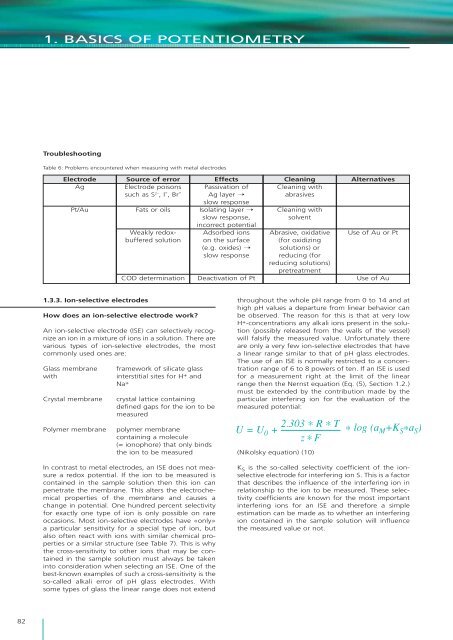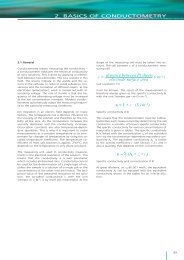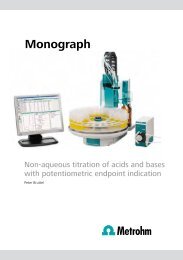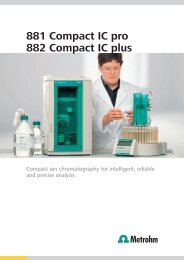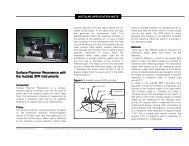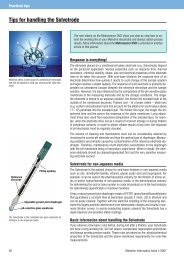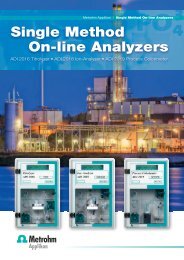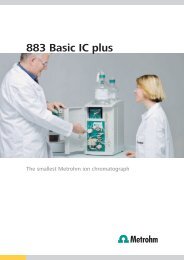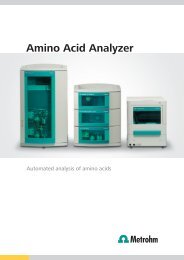What is the theoretical background of potentiometry? - Metrohm
What is the theoretical background of potentiometry? - Metrohm
What is the theoretical background of potentiometry? - Metrohm
Create successful ePaper yourself
Turn your PDF publications into a flip-book with our unique Google optimized e-Paper software.
1. BASICS OF POTENTIOMETRYTroubleshootingTable 6: Problems encountered when measuring with metal electrodesElectrodeAgPt/AuSource <strong>of</strong> errorElectrode po<strong>is</strong>onssuch as S 2– , I - , Br -Fats or oilsWeakly redoxbufferedsolutionCOD determinationEffectsPassivation <strong>of</strong>Ag layer ➝slow responseIsolating layer ➝slow response,incorrect potentialAdsorbed ionson <strong>the</strong> surface(e.g. oxides) ➝slow responseDeactivation <strong>of</strong> PtCleaningCleaning withabrasivesCleaning withsolventAbrasive, oxidative(for oxidizingsolutions) orreducing (forreducing solutions)pretreatmentAlternativesUse <strong>of</strong> Au or PtUse <strong>of</strong> Au1.3.3. Ion-selective electrodesHow does an ion-selective electrode work?An ion-selective electrode (ISE) can selectively recognizean ion in a mixture <strong>of</strong> ions in a solution. There arevarious types <strong>of</strong> ion-selective electrodes, <strong>the</strong> mostcommonly used ones are:Glass membranewithCrystal membranePolymer membraneframework <strong>of</strong> silicate glassinterstitial sites for H + andNa +crystal lattice containingdefined gaps for <strong>the</strong> ion to bemeasuredpolymer membranecontaining a molecule(= ionophore) that only binds<strong>the</strong> ion to be measuredIn contrast to metal electrodes, an ISE does not measurea redox potential. If <strong>the</strong> ion to be measured <strong>is</strong>contained in <strong>the</strong> sample solution <strong>the</strong>n th<strong>is</strong> ion canpenetrate <strong>the</strong> membrane. Th<strong>is</strong> alters <strong>the</strong> electrochemicalproperties <strong>of</strong> <strong>the</strong> membrane and causes achange in potential. One hundred percent selectivityfor exactly one type <strong>of</strong> ion <strong>is</strong> only possible on rareoccasions. Most ion-selective electrodes have «only»a particular sensitivity for a special type <strong>of</strong> ion, butalso <strong>of</strong>ten react with ions with similar chemical propertiesor a similar structure (see Table 7). Th<strong>is</strong> <strong>is</strong> why<strong>the</strong> cross-sensitivity to o<strong>the</strong>r ions that may be containedin <strong>the</strong> sample solution must always be takeninto consideration when selecting an ISE. One <strong>of</strong> <strong>the</strong>best-known examples <strong>of</strong> such a cross-sensitivity <strong>is</strong> <strong>the</strong>so-called alkali error <strong>of</strong> pH glass electrodes. Withsome types <strong>of</strong> glass <strong>the</strong> linear range does not extendthroughout <strong>the</strong> whole pH range from 0 to 14 and athigh pH values a departure from linear behavior canbe observed. The reason for th<strong>is</strong> <strong>is</strong> that at very lowH + -concentrations any alkali ions present in <strong>the</strong> solution(possibly released from <strong>the</strong> walls <strong>of</strong> <strong>the</strong> vessel)will falsify <strong>the</strong> measured value. Unfortunately <strong>the</strong>reare only a very few ion-selective electrodes that havea linear range similar to that <strong>of</strong> pH glass electrodes.The use <strong>of</strong> an ISE <strong>is</strong> normally restricted to a concentrationrange <strong>of</strong> 6 to 8 powers <strong>of</strong> ten. If an ISE <strong>is</strong> usedfor a measurement right at <strong>the</strong> limit <strong>of</strong> <strong>the</strong> linearrange <strong>the</strong>n <strong>the</strong> Nernst equation (Eq. (5), Section 1.2.)must be extended by <strong>the</strong> contribution made by <strong>the</strong>particular interfering ion for <strong>the</strong> evaluation <strong>of</strong> <strong>the</strong>measured potential:U = U 0 + 2.303 * R * T * log (a M +K S*a S )z * F(Nikolsky equation) (10)K S <strong>is</strong> <strong>the</strong> so-called selectivity coefficient <strong>of</strong> <strong>the</strong> ionselectiveelectrode for interfering ion S. Th<strong>is</strong> <strong>is</strong> a factorthat describes <strong>the</strong> influence <strong>of</strong> <strong>the</strong> interfering ion inrelationship to <strong>the</strong> ion to be measured. These selectivitycoefficients are known for <strong>the</strong> most importantinterfering ions for an ISE and <strong>the</strong>refore a simpleestimation can be made as to whe<strong>the</strong>r an interferingion contained in <strong>the</strong> sample solution will influence<strong>the</strong> measured value or not.82


